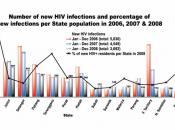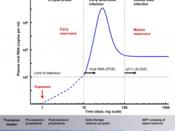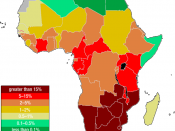INTRODUCTION As we all know, AIDS (Acquired Immune Deficiency Syndrome) is a fatal infection caused by the Human Immunodeficiency Virus (HIV). The virus attacks the body's immune system and, over a period of time, destroys it. This disables the body's ability to fight off infections by other germs and the growth of cancers, eventually resulting in death.
HOW IS HIV SPREAD? HIV is spread through the exchange of bodily fluids, which contain a high large amount of HIV such as blood, semen and vaginal secretions. The most common means of transmission is through unprotected sex and the sharing of dirty needles among drug users. Although HIV can be found in body substances such as saliva, tears and urine - the quantities in which they are found in are so low that they are relatively harmless.
WHO ARE AT RISK OF GETTING AIDS? Over 500 Singaporeans have been tested positive for HIV (up to late- 1996), however, this is probably only the tip of the iceberg as there are many others who are infected but do not know that they are.
In the 1980s, the majority of infections in Singapore were homosexual or bisexual men; but now there are many infections seen among heterosexual men and women. Heterosexual sex is now the main method of transmission in Singapore and over 75% of infections throughout the world are acquired through heterosexual intercourse.
Not everybody who has sex with an infected person will get infected. However, the risks increase sharply in the presence of other Sexually Transmitted Diseases (STD) i.e. gonorrhea, herpes and syphilis or when the infected person has symptoms of late HIV infection. Females have an eight times greater risk of catching the infection from an infected male than vice versa whereas anal intercourse without condoms carry the highest risk of and sexual activity. The chance of catching HIV from contaminated needles is extremely high (around 80%), the chance of a pregnant mother infecting her baby is between 15 to 30%.
CAN HIV BE SPREAD THROUGH CASUAL CONTACT? Although more than half of the general student population which we surveyed believed that HIV could be spread by insects such as mosquitoes, this is severely not the case. There has been absolutely no evidence that mosquitoes or any other biting insect can spread HIV. It has also been conclusively shown that the following cannot spread HIV: ÷ Health clubs ÷ Sneezing ÷ Touching ÷ Hugging ÷ Spitting ÷ Toilets ÷ Light kissing ÷ Bathrooms ÷ Sinks ÷ Shaking hands ÷ Gyms ÷ Food ÷ Eating utensils ÷ Massage HOW CAN HIV INFECTION BE PREVENTED? One foolproof way of avoiding HIV infection, is sexual abstinence. This method eludes not only HIV, but also other STDs and pregnancy. Having only one faithful sexual partner and avoiding sex with people who have many sexual partners can also reduce the risk of HIV infection. Practising safe sex and using a condom when having penetrative sex also helps in avoiding getting the virus.
For those who are addicted to drugs and injecting, needles should never be shared and equipment should always be cleaned with bleach after usage. People who wish to get tattooed or have their ears pierced should also be sure that the equipment used is new or sterilised between customers.
CONCLUSION Throughout the years, there has been a steady rise of HIV infected people since the early 1980s. These people were not necessarily homosexual or bisexual, in fact as we entered the 1990s, most of those infected were heterosexual. This shows that everybody is capable of getting AIDS if they are not careful.





